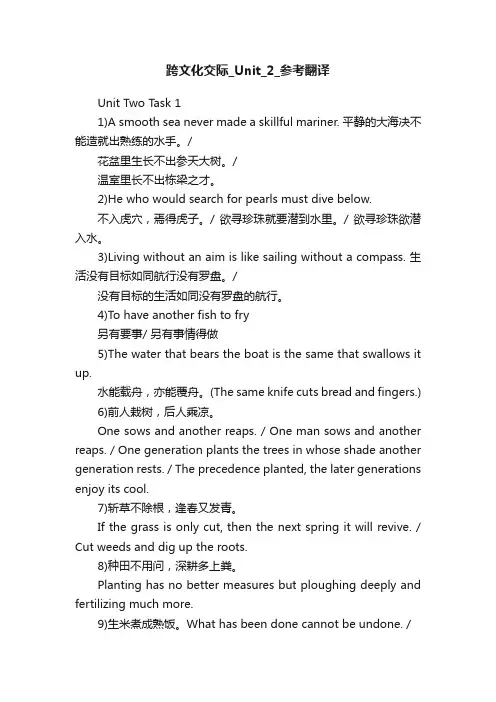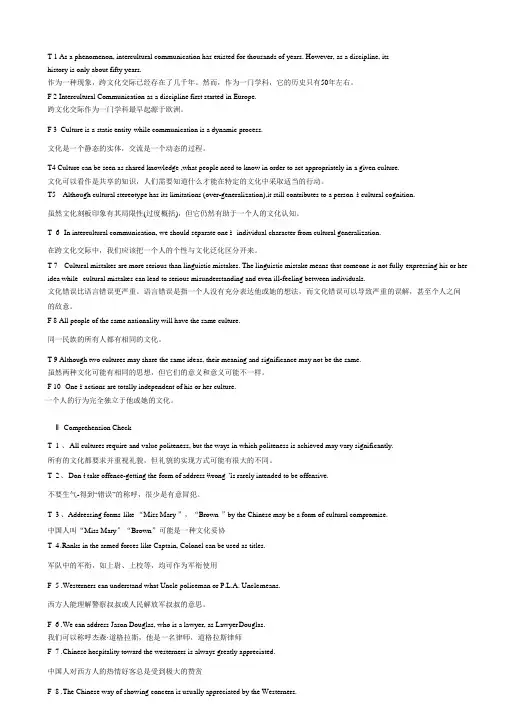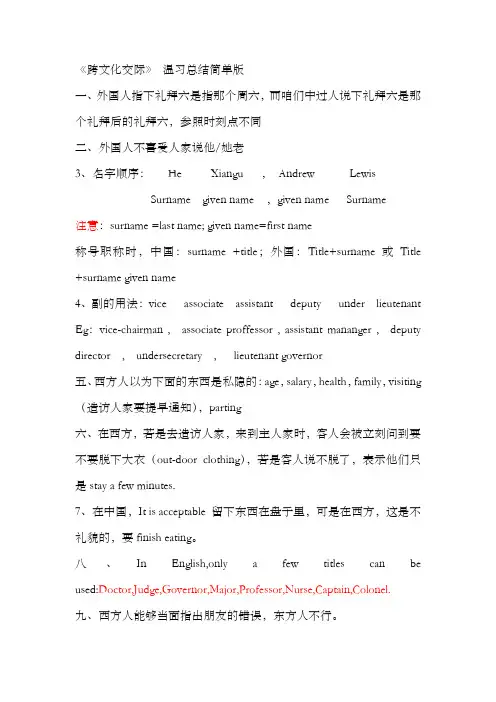跨文化交际实用教程胡超编著unit 2 & 3 daily verbal communication
跨文化Unit 2

9
Unit 2 Daily Verbal Communication (Ⅰ)
01 Warm-up Cases 02 Form of Address 03 Greeting 04 Initiating Conversation
and Conversation Topic 05 Visiting 06 Parting 07 Exercises
01 Warm-up Cases 02 Form of Address 03 Greeting 04 Initiating Conversation
and Conversation Topic 05 Visiting 06 Parting 07 Exercises
Unit 2 Daily Verbal Communication (Ⅰ)
Unit 2 Daily Verbal Communication (Ⅰ)
19
05 Visiting
Things to be minded
n Invite: advance notice (at least a week in advance) n Take off the out-door clothing immediately, if not, they would consider you
15
04 Initiating Conversation and Conversation Topic
Case Borrow Money and Lend Money (P21)
Americans don’t readily give money to others nor receive others’ readily. Americans keep reminding, but Chinese are shy of reminding.
跨文化交际实用教程unit2

gererosity
criticalness sarcasm humor
24
Case 5. Borrow Money & Lend Money
Question 1: If you were “I” in this case, how would you adjust yourself? Question 2: What’s the response of the the American if you are generous and say: “Don’t mention it again. You don’t have to pay me back.”
Title+Surname
Surname+Title Given Name
Title+Surname Given Name Given Name
9
How to express fu +title?
Please match the following two groups.
vice associate assistant
行政头衔以副字的表示副职的行政职务头衔可用vicedeputy表达
Unit 2
Daily Communication (I)
Objectives
Learn the differences of addressing
people and greeting between Chinese and western culture. Learn what are the topics at the beginning of the conversation. Learn how to visit someone and how to leave.
最新《新编跨文化交际英语教程》复习资料U2

精品资料《新编跨文化交际英语教程》复习资料U2........................................Unit 2 Culture and CommunicationSome Ideas Related to Culture and Communication 1. Various Definitions of CultureThe word culture has numerous meanings. It is said that there are more than 150 definitions about culture. Culture was treated earlier as a complex whole of our social traditions and as a prerequisite for us to be a member of the society. Culture can be a set of fundamental ideas, practices, and experiences of a group of people that are symbolically transmitted generation to generation through a learning process. Culture may as well refer to beliefs, norms, and attitudesthat are used to guide our behaviors and solve human problem.2. Culture as a Way to Satisfy Human Needsa) the physiological needsb) the safety needsc) the belongingness needsd) the esteem needse) the self-actualization needs— Abraham Maslow, a psychologist3. Culture as an IcebergCulture is compared to an iceberg that one tenth of it is above the water and nine tenths is below the water. The part above water is the overt culture which can be seen clearly, while the part below water is the deep culture which is out of our awareness.4. Characteristics of Culturea) Culture is holistic.This characteristic underscores the complex nature of culture. As a holistic system, an education system, a religious system, an association system, a political system, and so on, the various aspects of culture are closely interrelated. In other worlds, any change in a subsystem will affect the whole system. For example, the American Civil Rights Movement brought about changes in different facets of American culture and altered American attitude, values, and behaviors.b) Culture is acquired.We begin to consciously and unconsciously learn our culture in our early life through the process of socialization or enculturation. Interaction with family members and friends is the most common way for us to learn our culture. Other sources for learning our culture are schools, churches, media, folk tales, and art.c) Culture is changing.Cultures are constantly changing over time. Some cultures are more open and accepting of change, others tend to resist it. Cultures change in the process of transmission from generation to generation, group to gr oup, and place to place. The American Civil War and China’s Opium War brought great social and cultural changes to both societies.d) Culture is pervasive.Like the ubiquitous air we breathe, culture penetrates into every aspect of our life and influences the way we think, the way we talk, and the way we behave. Culture combines visible and invisible things around us. Culture is the sum total of human society and its meanings.5. Some Components of CommunicationThe communication process involves the following interrelated elements: the context of the communication, the participants, the message being communicated, the channels through which the communication occurs, the presence or absence of “noise”, and the verbal and nonverbal responses known as feedback.Context; Source;Encoding;Message;Channels; Noise;Feedback;Receiver;Decoding;Receiver’s responseReading IWhat Is CultureComprehension questions1. Which of the definitions given above do you prefer? Why?Some may prefer a short definition, such as the one given by E. Sapir or R. Benedict, for it is highly generalized and easy to remember. Some may prefer a longer one, such as Edward T. Hall‘s definition of culture, because it provides us with a more comprehensive understanding of culture and points out the all-pervasive impact of culture on human life in different dimensions.2.What have you learned from those definitions about culture?Many things can be learned from those definitions, for each definition, though not without its limitations, tells us something very important about culture or certain aspect(s) of culture.3. Do you agree that our lower needs always have to be satisfied before we can try to satisfy the higher needs?Even though this is generally the case, there will still be some exceptions. Sometimes people might prefer to satisfy higher needs, for instance, esteem needs, before their lower needs, such as certain physiological needs or safety needs are satisfied.4. What examples can you give about how people of different cultures achieve the same ends by taking different roads?For example, everyone has to eat in order to live and this is universally true. However, to satisfy this basic need, people of various cultures may do it in very different ways: what to eat and how to eat it vary from culture to culture.5. What behaviors of ours are born with and what are learned in the cultural environment? Instinctive behaviors are behaviors that we are born with and ways of doing things in daily life, such as ways of eating, drinking, dressing, finding shelter, making friends, marrying, and dealing with death are learned in the cultural environment.6. What other cultural differences do you know in the way people do things in their everyday life?We can also find cultural differences in ways of bringing up children, treating the elderly, greeting each other, saving and spending money, and many other things people do in everyday life.7. In what ways are the Chinese eating habits different from those of the English-speaking countries?We Chinese may enjoy something that is not usually considered as edible by theEnglish-speaking people. Generally we prefer to have things hot and lay much emphasis on tastes. We tend to share things with each other when we are eating with others.Reading IIElements of CommunicationComprehension questions1. What are the aspects of context mentioned above?One aspect of context is the physical setting, including location, time, light, temperature, distance between communicators, and any seating arrangements. A second aspect of context is historical. A third aspect of context is psychological. A fourth aspect of context is culture.2. In what ways would your posture, manner of speaking or attire change if you move from one physical setting to another, for example, from your home to a park, to a classroom, to a restaurant, to a funeral house, etc?One‘s posture, manner of speaking or attire change from being casual to formal gradually from home to a park, to a classroom, to a restaurant, to a funeral house, etc, according to different formalness and seriousness of these situations.3. How do people acquire communication norms in their life?People acquire communication norms from their experiences in life.4. What examples can you give to describe some Chinese norms in our everyday communication?For example, it seems to be a norm in China to address one‘s boss by his or her title and never to express one‘s disapproval directly to him or her.5. How can we play both the roles of sender and receiver in communication?As senders, we form messages and attempt to communicate them to others through verbal and nonverbal symbols. As receivers, we process the messages sent to us and react to them both verbally and nonverbally.6. Does the sender plays a more important role than the receiver in communication?No, they are equally important for both of them are essential in the process of communication.7. In what ways do the differences between participants make communication more or less difficult?Three especially important variables affecting participants which are relationship, gender, and culture make communication more or less difficult.8. What is a symbol and what is a meaning?The pure ideas and feelin gs that exist in a person‘s mind represent meanings. The words, sounds, and actions that communicate meaning are known as symbols because they stand for the meanings intended by the person using them.9. How can meanings be transferred from one person to another? What problems may arise in this process?A message from one person is encoded into symbols and then decoded into ideas and feelings to another person. In this process of transforming include nonverbal cues, whichsignificantly affect the meaning created between the participants in a communication transaction.10. When are unintended or conflicted meanings likely to be created?Unintended meanings are created when the decoding person receives a meaning unrelated to what the encoder thought he or she was communicating. Conflicting meanings are created when the verbal symbols are contradicted by the nonverbal cues.11. Which channels do you usually prefer in communication? Why?Of the five channels, some may prefer sight. As the old saying goes, words are but wind, but seeing is believing.12. What examples can you find to show that one channel is more effective than others for transmitting certain messages?For example, when asking a lady for a date, a young man may wear an immaculate suit and spray some perfume to show that he highly values this date with her. In this case, sight and smell are definitely more effective than words for conveying that particular message.13. What are the things that can create noises in the process of communication?Sights, sounds, and other stimuli in the environment that draw people‘s attention away from intended meaning are known as external noise. Thoughts and feelings that interfere with the communication process are known as internal noise. Unintended meanings aroused by certain verbal symbols can inhibit the accuracy of decoding. This is known as semantic noise.14. What should we do to reduce the interference of noise in communication?When communicating with others, we should pay undivided attention to communication itself, avoiding being distracted by any external or internal noise. Besides, we should make sure that what we say is correctly understood by others and vice versa to prevent semantic noise from generating.15. Why is feedback a very important element of communication?Feedback is very important because it serves useful functions for both senders and receivers: it provides senders with the opportunity to measure how they are coming across, and it provides receivers with the opportunity to exert some influence over the communication process.16. What will you usually do when you receive negative feedback in communication?Open.Case StudyCase 5In China, it is often not polite to accept a first offer and Heping was being modest, polite and well-behaved and had every intention of accepting the beer at the second or third offer. But he had not figured on North American rules which firmly say that you do not push alcoholic beverages on anyone. A person may not drink for religious reasons, he may be a reformed alcoholic, or he may be allergic. Whatever the reason behind the rule, you do not insist in offering alcohol. So unconscious and so strong are their cultural rules that the Americans equally politely never made a second offer of beer to Heping who probably thought North Americans most uncouth.However, what we have to remember is that cultures are seldom a strict either-or in everyinstance for all people and there are always individual differences. Probably this young Chinese nurse was very different from Heping or, unlike Heping, she may have known something about the American cultural rules and was just trying to behave like an American when she was in an American family.Case 6When a speaker says something to a hearer, there are at least three kinds of meanings involved: utterance meaning, speaker‘s meaning and hearer‘s meaning. In the dialogue, when Litz said ‗How long is she going to stay?‘ she meant to say that if she knew how long her mother-in-law was going to stay in Finland, she would be able to make proper arrangements for her, such as taking her out to do some sightseeing. However, her mother-in-law overheard the conversation, and took Litz‘s question to mean ―Litz does not want me to stay for long‖. From the Chinese point of view, it seems to be inappropriate for Litz to ask such a question just two days after her mother-in-law‘s arrival. If she feels she has to ask the question, it would be better to ask some time later and she should not let her mother-in-law hear it.Case 7Keiko insists on giving valuable gifts to her college friends, because in countries like Japan, exchanging gifts is a strongly rooted social tradition. Should you receive a gift, and don‘t have one to offer in return, you will probably create a crisis. If not as serious as a crisis, one who doesn‘t offer a gift in return may be considered rude or impolite. Therefore, in Japan, gifts are a symbolic way to show appreciation, respect, gratitude and further relationship.Keiko obviously has taken those used items from Mary, Ed and Marion as gifts, for she probably doesn‘t know that Americans frequently donate their used household items to church or to the community. Mary, Ed and Marion would never consider those used household items given to Keiko as gifts. No wonder they felt very uncomfortable when they received valuable gifts in return.Case 8As the Chinese girl Amy fell in love with an American boy at that time, it seems that she preferred to celebrate Christmas in the American way, for she wanted very much to appear the same as other American girl. She did not like to see her boyfriend feel disappointed atthe ―shabby Chinese Christmas. That‘s why she cried when she found out her parents had invited the minister‘s family over for the Christmas Eve dinner. She thought the menu for the Christmas meal created by her mother a strange one because there were no roast turkey and sweet potatoes but only Chinese food. How could she notice then the foods chosen by her mother were all her favorites?From this case, we can find a lot of differences between the Chinese and Western cultures in what is appropriate food for a banquet, what are good table manners, and how one should behave to be hospitable. However, one should never feel shameful just because one‘s culture is different from others‘. As Amy‘s mother told her, you must be proud to be different, and your only shame is to have shame.。
跨文化交际_Unit_2_参考翻译

跨文化交际_Unit_2_参考翻译Unit Two Task 11)A smooth sea never made a skillful mariner. 平静的大海决不能造就出熟练的水手。
/花盆里生长不出参天大树。
/温室里长不出栋梁之才。
2)He who would search for pearls must dive below.不入虎穴,焉得虎子。
/ 欲寻珍珠就要潜到水里。
/ 欲寻珍珠欲潜入水。
3)Living without an aim is like sailing without a compass. 生活没有目标如同航行没有罗盘。
/没有目标的生活如同没有罗盘的航行。
4)To have another fish to fry另有要事/ 另有事情得做5)The water that bears the boat is the same that swallows it up.水能载舟,亦能覆舟。
(The same knife cuts bread and fingers.)6)前人栽树,后人乘凉。
One sows and another reaps. / One man sows and another reaps. / One generation plants the trees in whose shade another generation rests. / The precedence planted, the later generations enjoy its cool.7)斩草不除根,逢春又发青。
If the grass is only cut, then the next spring it will revive. / Cut weeds and dig up the roots.8)种田不用问,深耕多上粪。
Planting has no better measures but ploughing deeply and fertilizing much more.9)生米煮成熟饭。
(完整word版)跨文化交际实用教程胡超版U1-U8判断题答案及翻译

T 1 As a phenomenon, intercultural communication has existed for thousands of years. However, as a discipline, itshistory is only about fifty years.作为一种现象,跨文化交际已经存在了几千年。
然而,作为一门学科,它的历史只有50年左右。
F 2 Intercultural Communication as a discipline first started in Europe.跨文化交际作为一门学科最早起源于欧洲。
F 3 Culture is a static entity while communication is a dynamic process.文化是一个静态的实体,交流是一个动态的过程。
T4 Culture can be seen as shared knowledge ,what people need to know in order to act appropriately in a given culture.文化可以看作是共享的知识,人们需要知道什么才能在特定的文化中采取适当的行动。
T5 Although cultural stereotype has its limitations (over-generalization),it still contributes to a person ’s cultural cognition.虽然文化刻板印象有其局限性(过度概括),但它仍然有助于一个人的文化认知。
T 6 In intercultural communication, we should separate one ’s individual character from cultural generalization.在跨文化交际中,我们应该把一个人的个性与文化泛化区分开来。
跨文化交际课程温习适用于胡超编著的讲义

《跨文化交际》温习总结简单版一、外国人指下礼拜六是指那个周六,而咱们中过人说下礼拜六是那个礼拜后的礼拜六,参照时刻点不同二、外国人不喜爱人家说他/她老3、名字顺序:He Xiangu ,Andrew LewisSurname given name ,given name Surname注意:surname =last name; given name=first name称号职称时,中国:surname +title;外国:Title+surname 或Title +surname given name4、副的用法:vice associate assistant deputy under lieutenant Eg:vice-chairman , associate proffessor , assistant mananger , deputy director , undersecretary , lieutenant governor五、西方人以为下面的东西是私隐的:age,salary,health,family,visiting (造访人家要提早通知),parting六、在西方,若是去造访人家,来到主人家时,客人会被立刻问到要不要脱下大衣(out-door clothing),若是客人说不脱了,表示他们只是stay a few minutes.7、在中国,It is acceptable 留下东西在盘子里,可是在西方,这是不礼貌的,要finish eating。
八、In English,only a few titles can be used:Doctor,Judge,Governor,Major,Professor,Nurse,Captain,Colonel.九、西方人能够当面指出朋友的错误,东方人不行。
10、加拿大人:No seeing out when Guest leaves.No stand-up when your leaders comes in.No help for old people.1一、Positively commenting on somenting can indicate that the speaker like to possess it.因其中国人一听到人家说“I love your scarf,It is really pretty”赞美她的东西,就会坚持要送给人家。
跨文化交际unit2
跨文化交际unit2跨文化交际Unit 2教学目标:Through this unit, Ss can get a general idea of the differences between Chinese people and the Western people to make some daily verbal communication. Ss can also know how to avoid making misunderstanding or dealing with the cultural puzzles under such situations.教学内容:Unit 2 Daily Verbal Communication教学重点与难点:The analysis and understanding of the differences between Chinese people and the Western people to make some daily verbal communication.教学过程:Step 1 Gua sha---A film directly dealing with cultural conflicts.Qs for discussion: (Please try to be objective in discussion)1. How well do you know about American freedom? What are the differences between American freedom and Chinese freedom?2. “Gua sha”, a traditional Chinese medical treatment, was unrecognized by American culture. What do you think of it?3. Can American understand the Chinese filial piety孝道and the Chinese slang “打是亲,骂是爱”?Why?4. Why can’t th e American understand the typical Chinese behavior: beating one’s child to show one’s respect or to give face to the other when the child did something wrong?5. Are there any other examples of the case that are taken for granted or common sense in one country while are considered unacceptable or illegal in another? What do you think of them? Could you find a possible solution?Cultural Differences:(1)American Dream VS Chinese Dream●House, car, a stable well-paid job.● A well-known saying-----“Where the re is no vision, the people perish.Where there is no vision, the America people will perish.”(Cliton, at a presidential election campaign in 1995) Characteristics of American Dream:● a kind of wish (Tomorrow will be better than today.)●reality and action (e.g. gold rush)●lack of artistic flavor (in Chinese’s eyes)●part of American spiritChinese:* Real, a dream forever* Waiting for a prince or princess (白雪公主与白马王子), or waiting for being discovered or promoted. (孔明,姜子牙) * a perfect dream, Utopia, related to hermitage travel赫米蒂奇旅行, leisure, Chinese painting, calligraphy 书法* Characteristics: passive; idealistic, quite spiritual, perfectOpen question: What lead to these differences?(2)American freedom VS Chinese freedomAlcoholic drinks (less than 21, forbidden)Cigarette smoking (less than 18, forbidden in cities)Children below 12 at home along (illegal)Job interview (not to be asked about such info as handicapped, birth place; marital status; age;immigrant info, child info, crime records; etc.)***Additional things: sexual harassment; gender discrimination; ethnic discrimination; moral evaluation; Chinese: good or bad, American: legal or illegal.Open Qs: How about Chinese freedom?What do you think of ruling country by law as well as by De? (依法治国,以德治国)Step 2: Presentation of the textPart 1: Form of Address2.1 Naming names(1) To make a comparison between a Chinese name and an English one.E.g. Zhou Xingchi Andrew Lewissurname (family name) given name given name surname (family name)(2) For most English people, they have 3 names (Christian name + Given name + Surname) and the first of the given names is usually used by them.E.g. Anthony John Ward(4) Sources of some names(5) Partents should be careful of giving names to their children:Nichola Ann Green: This is a girl's name with the initials NAG, which unfortunately spell the word meaning to continually complain in an irritating wa y, e.g., '“My wife never stops complaining. She nags me morning, noon, and night.”Fiona Alice Tanner: This is a girl's name with the initials FAT.Michael Adam Davies: This is a boy's name with the initials MAD.Peter Ewan Steven Thompson: This is a boy's name with the initials PEST.Graham Adam Yiend: This is a boy's name with the initials GAY. This has a number of different meanings. In the past it was simply used to mean 'happy', so would not have been avoided.Nowadays, however, it has acquired another meaning and is more frequently used to mean 'male homosexual'.Part 2: Addressing (P.22-25)Discussion:What are the most common forms of address for a man named “ Zhou Xingchi”?What are the common forms of address for a man named “Andrew Lewis”?What kind of mistakes may Chinese speakers make when addressing foreigners? Reasons? (To see the case on p.37:3) Three-step approach:分析方法:A “three-step approach” to case analysis isrecommended in this course. You may follow the three steps below when analyzing cross-cultural cases.Step 1: Normative-level analysis主要是进行背景分析,从书中理论着手At this step, these questions need to be addressed: what cultural differences made the involved parties behave in this way? What normative cultural attributes caused the cross-cultural clash? Step 2: Behavioral-level analysis行为分析,从文化差异入手。
《跨文化交际实用教程》一书的summary
3. 跨文化交际是具有不同文化背景的人之间的交际。跨文化交际作为研究领域是始于20世纪50年代的美国。跨文化交际的鼻祖,EdwardHall于1959年发表了《无声的语言》一书。也有研究发现是四种趋势----便捷的交通系统、创新的交流系统、经济全球化以及大范围的移民(Samovar & Porter,2003),促进了地球村全球化的发展。
第六单元:跨性别文化交际
第六单元介绍跨性别文化交际,介绍中外男女性别意识的差异所导致的文化差异,如谈话风格、行为习惯、思维方式的不同以及如何跨越这些障碍而达到彼此的沟通与理解。
性别可以分为社会性别和自然性别两种。
社会性别(gender)是指社会造成的基于性别(Sex)之上的思想、观念和行为模式,是后天习得的社会性角色,是由社会建构的差别即性构(gendered),是基于可见的性别差异之上的社会关系的构成要素,是表示权力关系的一种方式。社会性别(Gender)有别于自然性别(Sex),自然性别(sex)是男女的自然属性,即两性的先天的生物差异。对社会性别的两个最初影响分别是家庭沟通,特别是母亲与孩子的沟通,还有孩子之间平时的娱乐互动,研究表明女孩和男孩喜欢玩的游戏有很大的不同,女孩通常喜欢玩扮家家,捉迷藏或者跳绳,而男孩一般比较喜欢竞争性体育活动像踢足球打篮球之类的。
第一单元:绪论
绪论部分总体介绍了文化与交际、跨文化交际和跨文化交际学的基本知识。
1.文化成员分享着行为模式以及世界运行模式,然而,尽管在不同文化的冲击影响下,人的行为和习俗会发生快速的转变,但是人的价值观却很难因文化环境的不同而发生改变。
2. 交际在我们的生活中无处不在,存在三个因素影响着人们的交际。一是人的个性,二是所处的文化,三是所处的物理环境。交际是一种互动的行为。
跨文化交际实用教程unit2课件ppt共30页
1
CONTENTS
I. Warm-up cases II. Detailed Study:
★Addressing People ★Greetings ★Initiating Conversations ★Visiting Someone ★Partings
■学术头衔
学术头衔的“副”职称,常用 associate 表示。如:
➢ 副教授 associate professor ➢ 副研究员 associate research fellow ➢ 副审判长 associate judge ➢ 副主任医师 associate doctor
10
2. Greetings
Please match the following two groups.
vice
director
associate
professor
assistant
manager
deputy
president
9
Tips:
■行政头衔
以“副”字的表示副职的行政职务头衔,可用 vice、 deputy 表达。在实际使用时究竟选用哪个,纯属搭配 习惯。一般来说,vice与president、 premier、 chairman、 minister、 governor搭配;deputy与 director、 chief、head 、secretary、dean、mayor 搭配。似乎可以认为,Vice比Deputy的搭配级别要高。
Close Relationship/ Informal Situation
Surname+Title Surname+Title
跨文化交际课程unit2
Lecture 2: Code and Context
Intercultural communication VS Cross-cultural communication
The forms of intercultural communication
a.Interpersonal Communication
Interpersonal communication is a form of communication that involves a small number of individuals who are interacting exclusively with one another and who therefore have the ability both to adapt their messages sቤተ መጻሕፍቲ ባይዱecifically for those others and to obtain immediate interpretations from them.
The distinctions between HC and LC
HC communication is economical, fast, and efficient.It works very well as long as the people communicating are looking for and understand the meanings in the context. LC is more impersonal, but it is an effective way of transmitting information among people who do not share the same experience.
- 1、下载文档前请自行甄别文档内容的完整性,平台不提供额外的编辑、内容补充、找答案等附加服务。
- 2、"仅部分预览"的文档,不可在线预览部分如存在完整性等问题,可反馈申请退款(可完整预览的文档不适用该条件!)。
- 3、如文档侵犯您的权益,请联系客服反馈,我们会尽快为您处理(人工客服工作时间:9:00-18:30)。
Teaching Objectives • 1.To understand how language and culture are closely linked • 2. To understand pragmatics in intercultural Communication • 3. Identify the cultural differences in addressing, greeting, conversational topics, visiting, parting, compliment and response, gratitude and apology.
• The use of respectful titles to indicate people’s influential status
Company Logo
Special Greeting • literarily "Where are you going? " or "What are you goБайду номын сангаасng to do?" or "Have you eaten? “ (pg. 25)
• Invitation • Intrusion into one’s privacy
• Simply to say his/her name, perhaps adding a term of respect: Li Xiaosheng, Mr. Li, Teacher Li, etc.
• the Chinese person is preparing to ask a question or make a comment. • the American's response is likely to be "Yes?"
• Some exceptions • parents • Uncle Sam, Aunt Mary • Brother Joseph or Sister Mary (religious society)
Company Logo
Addressing by title, office, profession
• Nowadays, more and more English-speaking people address others by using the first name, even when people meet for the first time. (intimacy and equality) (pg. 23)
• Only a few occupations or titles could be used. (pg. 24)
• *Principal Morris; *Manager Jackson; *Bureau Director Wang • Doctor Brown; Mayor White; Prof. Lessing; Nurse Liu; Captain Fan; Colonel Yu
• Another Chinese term xinku la (辛苦啦) is a good warm expression showing concern with many functions.
• greeting to a person who has just completed a long trip, and as a greeting complement to a person who has just done something. • Did you have a good trip? / Did you enjoy your trip? / How was the trip? etc. • "Well done", "That was /You' ve got a hard job.”
Daily Verbal Communication
LOGO
An idiom
The sum of human wisdom is not contained in any one language, and no single language is capable of expressing all forms and degrees of human comprehension. — Ezra Pound
• More examples are jingcha shushu (警察叔叔), hushi aji (护士阿姨),etc.
• The English equivalents of the above kinship terms are not so used. Even with relatives, Americans tend to use just the first name and leave out the term of relationship.
Company Logo
What is verbal communication
• Verbal: connected with words and their use • Verbal communication: communication done both orally and in written language • Easier to use words to represent one’s experiences within the same culture because people share many similar experiences. • More troublesome in verbal communication across cultures because people’s experiences, beliefs, values, customs, traditions and the like are different.
Company Logo
Language and culture
• Mastering all those rules of language, such as phonology, morphology, syntax and semantics, is still not enough for effective communication, for language and culture cannot be separated. • They are intertwined, shaping each other, as in the chicken and egg dilemma --- which came first, the language or the culture? • When selecting words, forming sentences, and sending a message, either oral or written, one also makes cultural choices.
• Americans tend to regard titles as trivial unless they have a clear idea of what kind of work a person does and what his responsibilities are.
• Senior engineer / vice president for marketing
Company Logo
Addressing by relationship
• Chinese often extend kinship terms to people not related by blood or marriage. These terms are used after the surname to show politeness and respect. (pg. 23)
Company Logo
Addressing by names
• Name order
• Surname + given name / He Xiangu • Given name + surname (AE)/ Linda Smith • *Smith; *Miss Linda
• A child may even do so to his/ her parents or grandparents. • Many college students call their professors by their first names. (postgraduate)
• In China seniority is paid respect to. Juniors are supposed to address seniors in a proper way. The use of given names is limited to husband and wife, very close friends, juniors by elders or superiors. (Hierarchy)
Company Logo
Pragmatics in intercultural Communication • Language can be used to perform many tasks: to address people, to compliment people, to make a request, to extend an invitation, to declare a man and a woman husband and wife, and even to sentence a criminal to death. • Pragmatics is the study of the effect that language has on human perceptions and behavior. By learning pragmatics, we can understand how to communicate properly. • Our everyday communication is filled with such pragmatic use of language , but the realization of speech act is different from culture to culture.
